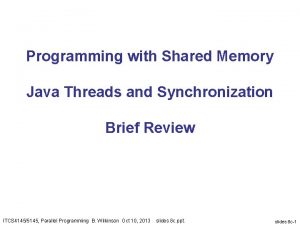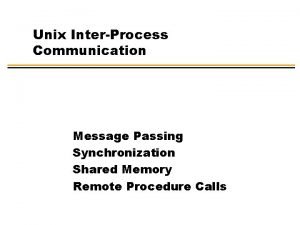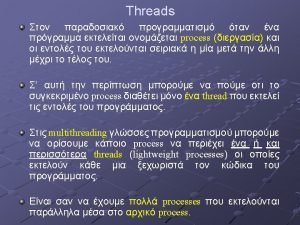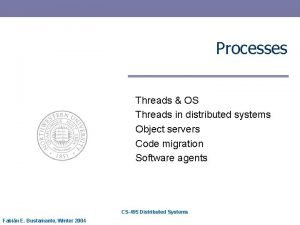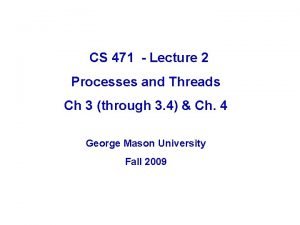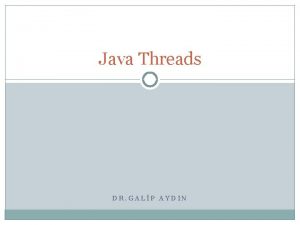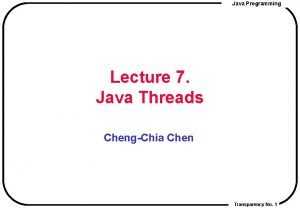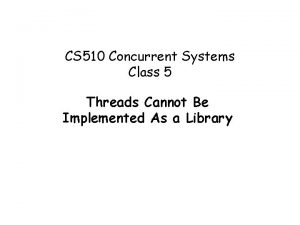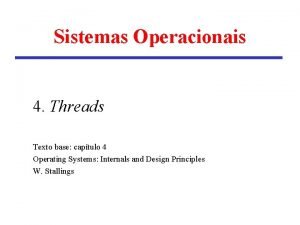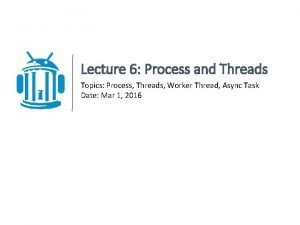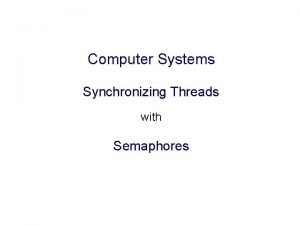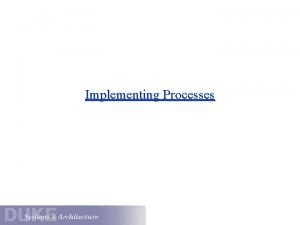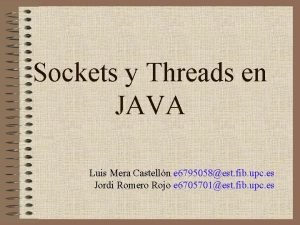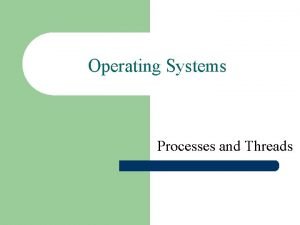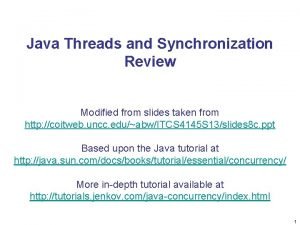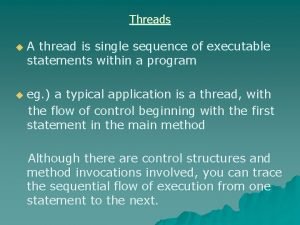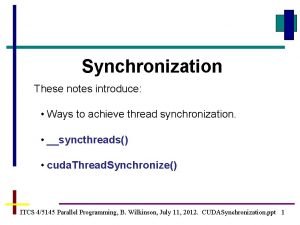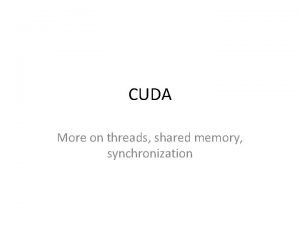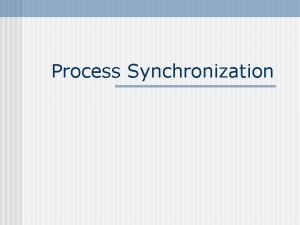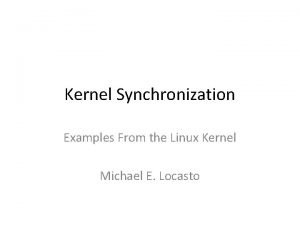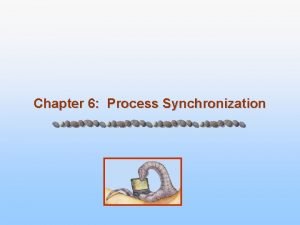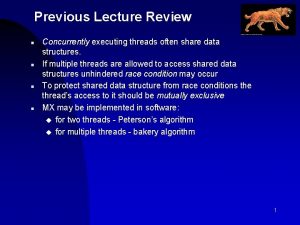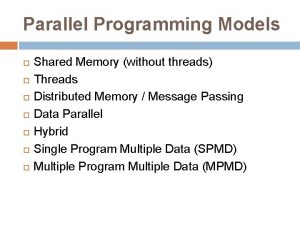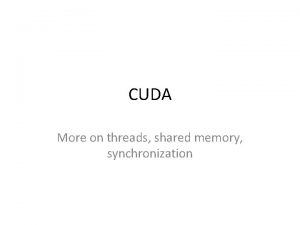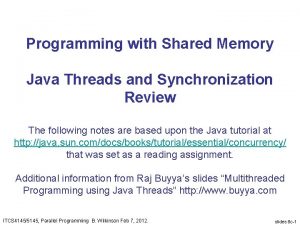Synchronization Synchronization Motivation When threads concurrently readwrite shared























































- Slides: 55

Synchronization

Synchronization Motivation • When threads concurrently read/write shared memory, program behavior is undefined – Two threads write to the same variable; which one should win? • Thread schedule is non-deterministic – Behavior changes when re-run program • Compiler/hardware instruction reordering • Multi-word operations are not atomic

Question: Can this panic? Thread 1 Thread 2 p = some. Computation(); p. Initialized = true; while (!p. Initialized) ; q = some. Function(p); if (q != some. Function(p)) panic

Why Reordering? • Why do compilers reorder instructions? – Efficient code generation requires analyzing control/data dependency – If variables can spontaneously change, most compiler optimizations become impossible • Why do CPUs reorder instructions? – Write buffering: allow next instruction to execute while write is being completed Fix: memory barrier – Instruction to compiler/CPU – All ops before barrier complete before barrier returns – No op after barrier starts until barrier returns

Too Much Milk Example Person A Person B 12: 30 Look in fridge. Out of milk. 12: 35 Leave for store. 12: 40 Arrive at store. Look in fridge. Out of milk. 12: 45 Buy milk. Leave for store. 12: 50 Arrive home, put milk away. Arrive at store. 12: 55 1: 00 Buy milk. Arrive home, put milk away. Oh no!

Definitions Race condition: output of a concurrent program depends on the order of operations between threads Mutual exclusion: only one thread does a particular thing at a time – Critical section: piece of code that only one thread can execute at once Lock: prevent someone from doing something – Lock before entering critical section, before accessing shared data – Unlock when leaving, after done accessing shared data – Wait if locked (all synchronization involves waiting!)

Too Much Milk, Try #1 • Correctness property – Someone buys if needed (liveness) – At most one person buys (safety) • Try #1: leave a note if (!note) if (!milk) { leave note buy milk remove note }

Too Much Milk, Try #2 Thread A Thread B leave note A if (!note B) { if (!milk) buy milk } remove note A leave note B if (!note. A) { if (!milk) buy milk } remove note B

Too Much Milk, Try #3 Thread A Thread B leave note A while (note B) // X do nothing; if (!milk) buy milk; remove note A leave note B if (!note. A) { // Y if (!milk) buy milk } remove note B Can guarantee at X and Y that either: (i) Safe for me to buy (ii) Other will buy, ok to quit

Lessons • Solution is complicated – “obvious” code often has bugs • Modern compilers/architectures reorder instructions – Making reasoning even more difficult • Generalizing to many threads/processors – Even more complex: see Peterson’s algorithm

Roadmap

Locks • Lock: : acquire – wait until lock is free, then take it • Lock: : release – release lock, waking up anyone waiting for it 1. At most one lock holder at a time (safety) 2. If no one holding, acquire gets lock (progress) 3. If all lock holders finish and no higher priority waiters, waiter eventually gets lock (progress)

Question: Why only Acquire/Release • Suppose we add a method to a lock, to ask if the lock is free. Suppose it returns true. Is the lock: – Free? – Busy? – Don’t know?

Too Much Milk, #4 Locks allow concurrent code to be much simpler: lock. acquire(); if (!milk) buy milk lock. release();

Lock Example: Malloc/Free char *malloc (n) { heaplock. acquire(); p = allocate memory heaplock. release(); return p; } void free(char *p) { heaplock. acquire(); put p back on free list heaplock. release(); }

Rules for Using Locks • Lock is initially free • Always acquire before accessing shared data structure – Beginning of procedure! • Always release after finishing with shared data – End of procedure! – Only the lock holder can release – DO NOT throw lock for someone else to release • Never access shared data without lock – Danger!

Will this code work? if (p == NULL) { lock. acquire(); if (p == NULL) { p = new. P(); } lock. release(); } use p->field 1 new. P() { p = malloc(sizeof(p)); p->field 1 = … p->field 2 = … return p; }

Example: Bounded Buffer tryget() { tryput(item) { item = NULL; lock. acquire(); if ((tail – front) < size) { if (front < tail) { buf[tail % MAX] = item; item = buf[front % MAX]; tail++; front++; } } lock. release(); } return item; } Initially: front = tail = 0; lock = FREE; MAX is buffer capacity

Question • If tryget returns NULL, do we know the buffer is empty? • If we poll tryget in a loop, what happens to a thread calling tryput?

Condition Variables • Waiting inside a critical section – Called only when holding a lock • Wait: atomically release lock and relinquish processor – Reacquire the lock when wakened • Signal: wake up a waiter, if any • Broadcast: wake up all waiters, if any

Condition Variable Design Pattern method. That. Waits() { lock. acquire(); // Read/write shared state } method. That. Signals() { lock. acquire(); // Read/write shared state while (!test. Shared. State()) { cv. wait(&lock); } // If test. Shared. State is now true cv. signal(&lock); // Read/write shared state lock. release(); }

Example: Bounded Buffer get() { lock. acquire(); while (front == tail) { empty. wait(lock); } item = buf[front % MAX]; front++; full. signal(lock); lock. release(); return item; } put(item) { lock. acquire(); while ((tail – front) == MAX) { full. wait(lock); } buf[tail % MAX] = item; tail++; empty. signal(lock); lock. release(); } Initially: front = tail = 0; MAX is buffer capacity empty/full are condition variables

Pre/Post Conditions • What is state of the bounded buffer at lock acquire? – front <= tail – front + MAX >= tail • These are also true on return from wait • And at lock release • Allows for proof of correctness

Pre/Post Conditions method. That. Waits() { lock. acquire(); // Pre-condition: State is consistent } method. That. Signals() { lock. acquire(); // Pre-condition: State is consistent // Read/write shared state while (!test. Shared. State()) { cv. wait(&lock); } // WARNING: shared state may // have changed! But // test. Shared. State is TRUE // and pre-condition is true // If test. Shared. State is now true cv. signal(&lock); // Read/write shared state lock. release(); // NO WARNING: signal keeps lock } // Read/write shared state lock. release();

Condition Variables • ALWAYS hold lock when calling wait, signal, broadcast – Condition variable is sync FOR shared state – ALWAYS hold lock when accessing shared state • Condition variable is memoryless – If signal when no one is waiting, no op – If wait before signal, waiter wakes up • Wait atomically releases lock – What if wait, then release? – What if release, then wait?

Condition Variables, cont’d • When a thread is woken up from wait, it may not run immediately – Signal/broadcast put thread on ready list – When lock is released, anyone might acquire it • Wait MUST be in a loop while (need. To. Wait()) { condition. Wait(lock); } • Simplifies implementation – Of condition variables and locks – Of code that uses condition variables and locks

Java Manual When waiting upon a Condition, a “spurious wakeup” is permitted to occur, in general, as a concession to the underlying platform semantics. This has little practical impact on most application programs as a Condition should always be waited upon in a loop, testing the state predicate that is being waited for.

Structured Synchronization • Identify objects or data structures that can be accessed by multiple threads concurrently – In OS/161 kernel, everything! • Add locks to object/module – Grab lock on start to every method/procedure – Release lock on finish • If need to wait – while(need. To. Wait()) { condition. Wait(lock); } – Do not assume when you wake up, signaller just ran • If do something that might wake someone up – Signal or Broadcast • Always leave shared state variables in a consistent state – When lock is released, or when waiting

Remember the rules • Use consistent structure • Always use locks and condition variables • Always acquire lock at beginning of procedure, release at end • Always hold lock when using a condition variable • Always wait in while loop • Never spin in sleep()

Mesa vs. Hoare semantics • Mesa – Signal puts waiter on ready list – Signaller keeps lock and processor • Hoare – Signal gives processor and lock to waiter – When waiter finishes, processor/lock given back to signaller – Nested signals possible!

FIFO Bounded Buffer (Hoare semantics) get() { lock. acquire(); if (front == tail) { empty. wait(lock); } item = buf[front % MAX]; front++; full. signal(lock); lock. release(); return item; } put(item) { lock. acquire(); if ((tail – front) == MAX) { full. wait(lock); } buf[last % MAX] = item; last++; empty. signal(lock); // CAREFUL: someone else ran lock. release(); } Initially: front = tail = 0; MAX is buffer capacity empty/full are condition variables

FIFO Bounded Buffer (Mesa semantics) • • Create a condition variable for every waiter Queue condition variables (in FIFO order) Signal picks the front of the queue to wake up CAREFUL if spurious wakeups! • Easily extends to case where queue is LIFO, priority donation, … – With Hoare semantics, not as easy

FIFO Bounded Buffer (Mesa semantics, put() is similar) get() { lock. acquire(); my. Position = num. Gets++; self = new Condition; next. Get. append(self); while (front < my. Position || front == tail) { self. wait(lock); } delete self; item = buf[front % MAX]; front++; if (next = next. Put. remove()) { next->signal(lock); } lock. release(); return item; } Initially: front = tail = num. Gets = 0; MAX is buffer capacity next. Get, next. Put are queues of Condition Variables

Implementing Synchronization

Implementing Synchronization Take 1: using memory load/store – See too much milk solution/Peterson’s algorithm Take 2: Lock: : acquire() { disable interrupts } Lock: : release() { enable interrupts }

Lock Implementation, Uniprocessor Lock: : acquire() { disable. Interrupts(); if (value == BUSY) { waiting. add(my. TCB); my. TCB->state = WAITING; next = ready. List. remove(); switch(my. TCB, next); my. TCB->state = RUNNING; } else { value = BUSY; } enable. Interrupts(); } Lock: : release() { disable. Interrupts(); if (!waiting. Empty()) { next = waiting. remove(); next->state = READY; ready. List. add(next); } else { value = FREE; } enable. Interrupts(); }

Multiprocessor • Read-modify-write instructions – Atomically read a value from memory, operate on it, and then write it back to memory – Intervening instructions prevented in hardware • Examples – Test and set – Intel: xchgb, lock prefix – Compare and swap • Any of these can be used for implementing locks and condition variables!

Spinlocks A spinlock is a lock where the processor waits in a loop for the lock to become free – Assumes lock will be held for a short time – Used to protect the CPU scheduler and to implement locks Spinlock: : acquire() { while (test. And. Set(&lock. Value) == BUSY) ; } Spinlock: : release() { lock. Value = FREE; memorybarrier(); }

How many spinlocks? • Various data structures – Queue of waiting threads on lock X – Queue of waiting threads on lock Y – List of threads ready to run • One spinlock per kernel? – Bottleneck! • Instead: – One spinlock per lock – One spinlock for the scheduler ready list • Per-core ready list: one spinlock per core

What thread is currently running? • Thread scheduler needs to find the TCB of the currently running thread – To suspend and switch to a new thread – To check if the current thread holds a lock before acquiring or releasing it • On a uniprocessor, easy: just use a global • On a multiprocessor, various methods: – Compiler dedicates a register (e. g. , r 31 points to TCB running on the this CPU; each CPU has its own r 31) – If hardware has a special per-processor register, use it – Fixed-size stacks: put a pointer to the TCB at the bottom of its stack • Find it by masking the current stack pointer

Lock Implementation, Multiprocessor Lock: : acquire() { disable. Interrupts(); spin. Lock. acquire(); if (value == BUSY) { waiting. add(my. TCB); suspend(&spinlock); } else { value = BUSY; } spin. Lock. release(); enable. Interrupts(); } Lock: : release() { disable. Interrupts(); spin. Lock. acquire(); if (!waiting. Empty()) { next = waiting. remove(); scheduler->make. Ready(next); } else { value = FREE; } spin. Lock. release(); enable. Interrupts(); }

Compare Implementations Semaphore: : P() { disable. Interrupts(); spin. Lock. acquire(); if (value == 0) { waiting. add(my. TCB); suspend(&spinlock); } else { value--; } spin. Lock. release(); enable. Interrupts(); } Semaphore: : V() { disable. Interrupts(); spin. Lock. acquire(); if (!waiting. Empty()) { next = waiting. remove(); scheduler->make. Ready(next); } else { value++; } spin. Lock. release(); enable. Interrupts(); }

Lock Implementation, Multiprocessor Sched: : suspend(Spin. Lock ∗lock) { TCB ∗next; } disable. Interrupts(); sched. Spin. Lock. acquire(); lock−>release(); my. TCB−>state = WAITING; next = ready. List. remove(); thread_switch(my. TCB, next); my. TCB−>state = RUNNING; sched. Spin. Lock. release(); enable. Interrupts(); Sched: : make. Ready(TCB ∗thread) { } disable. Interrupts (); sched. Spin. Lock. acquire(); ready. List. add(thread); thread−>state = READY; sched. Spin. Lock. release(); enable. Interrupts();

Lock Implementation, Linux • Most locks are free most of the time – Why? – Linux implementation takes advantage of this fact • Fast path – If lock is FREE, and no one is waiting, two instructions to acquire the lock – If no one is waiting, two instructions to release the lock • Slow path – If lock is BUSY or someone is waiting, use multiproc impl. • User-level locks – Fast path: acquire lock using test&set – Slow path: system call to kernel, use kernel lock

Lock Implementation, Linux struct mutex { /∗ 1: unlocked ; 0: locked; negative : locked, possible waiters ∗/ atomic_t count; spinlock_t wait_lock; struct list_head wait_list; }; // atomic decrement // %eax is pointer to count lock decl (%eax) jns 1 f // jump if not signed // (if value is now 0) call slowpath_acquire 1:

Semaphores • Semaphore has a non-negative integer value – P() atomically waits for value to become > 0, then decrements – V() atomically increments value (waking up waiter if needed) • Semaphores are like integers except: – Only operations are P and V – Operations are atomic • If value is 1, two P’s will result in value 0 and one waiter • Semaphores are useful for – Unlocked wait: interrupt handler, fork/join

Semaphore Bounded Buffer get() { full. Slots. P(); mutex. P(); item = buf[front % MAX]; front++; mutex. V(); empty. Slots. V(); return item; } put(item) { empty. Slots. P(); mutex. P(); buf[last % MAX] = item; last++; mutex. V(); full. Slots. V(); } Initially: front = last = 0; MAX is buffer capacity mutex = 1; empty. Slots = MAX; full. Slots = 0;

Implementing Condition Variables using Semaphores (Take 1) wait(lock) { lock. release(); semaphore. P(); lock. acquire(); } signal() { semaphore. V(); }

Implementing Condition Variables using Semaphores (Take 2) wait(lock) { lock. release(); semaphore. P(); lock. acquire(); } signal() { if (semaphore is not empty) semaphore. V(); }

Implementing Condition Variables using Semaphores (Take 3) wait(lock) { semaphore = new Semaphore; queue. Append(semaphore); // queue of waiting threads lock. release(); semaphore. P(); lock. acquire(); } signal() { if (!queue. Empty()) { semaphore = queue. Remove(); semaphore. V(); // wake up waiter } }

Communicating Sequential Processes (CSP/Google Go) • A thread per shared object – Only thread allowed to touch object’s data – To call a method on the object, send thread a message with method name, arguments – Thread waits in a loop, get msg, do operation • No memory races!

Example: Bounded Buffer get() { lock. acquire(); while (front == tail) { empty. wait(lock); } item = buf[front % MAX]; front++; full. signal(lock); lock. release(); return item; } put(item) { lock. acquire(); while ((tail – front) == MAX) { full. wait(lock); } buf[tail % MAX] = item; tail++; empty. signal(lock); lock. release(); } Initially: front = tail = 0; MAX is buffer capacity empty/full are condition variables

Bounded Buffer (CSP) while (cmd = get. Next()) { if (cmd == GET) { if (front < tail) { // do get // send reply // if pending put, do it // and send reply } else // queue get operation } } else { // cmd == PUT if ((tail – front) < MAX) { // do put // send reply // if pending get, do it // and send reply } else // queue put operation }

Locks/CVs vs. CSP • Create a lock on shared data = create a single thread to operate on data • Call a method on a shared object = send a message/wait for reply • Wait for a condition = queue an operation that can’t be completed just yet • Signal a condition = perform a queued operation, now enabled

Remember the rules • Use consistent structure • Always use locks and condition variables • Always acquire lock at beginning of procedure, release at end • Always hold lock when using a condition variable • Always wait in while loop • Never spin in sleep()
 Http_twitter
Http_twitter Concurrently maintainable
Concurrently maintainable Shared memory in java
Shared memory in java Posix shared memory synchronization
Posix shared memory synchronization Needle like threads of spongy bone
Needle like threads of spongy bone /threads/ fiji
/threads/ fiji Internal screw thread
Internal screw thread Pintos threads
Pintos threads Os threads
Os threads Threads in distributed systems
Threads in distributed systems Forum.unity.com/threads/game-over.54735
Forum.unity.com/threads/game-over.54735 Process and threads
Process and threads Threads java
Threads java Chia number of threads
Chia number of threads Threads cannot be implemented as a library
Threads cannot be implemented as a library Threads.h
Threads.h Epri iwc
Epri iwc Mustafa cem kasapbaşı
Mustafa cem kasapbaşı Process and threads
Process and threads Pintos manual
Pintos manual Mission thread example
Mission thread example Ashvin goel
Ashvin goel Process thread
Process thread Os threads
Os threads Osteospermum white lightning
Osteospermum white lightning Threads vs processes
Threads vs processes The kernel is unaware of user threads
The kernel is unaware of user threads Golden thread management
Golden thread management Sockets and threads
Sockets and threads A flexible flat material made by interlacing threads/fibers
A flexible flat material made by interlacing threads/fibers Threads in operating system
Threads in operating system Threads em java
Threads em java What is thread in operating system
What is thread in operating system Sequence diagram threads
Sequence diagram threads The drilling head contains mcq
The drilling head contains mcq Vinaya pitaka is a sacred text of
Vinaya pitaka is a sacred text of Forum.unity.com/threads/game-over.54735
Forum.unity.com/threads/game-over.54735 C11 thread
C11 thread Scheduler activation
Scheduler activation Syncthreads
Syncthreads Posix threads
Posix threads Pthreads
Pthreads Escalonamento por prioridades
Escalonamento por prioridades Ece threads
Ece threads Cuprintf
Cuprintf Threads cannot be implemented as a library
Threads cannot be implemented as a library Synchronization primitives c#
Synchronization primitives c# Process synchronization definition
Process synchronization definition Simple bgp configuration example
Simple bgp configuration example Cs 4414 cornell
Cs 4414 cornell Dining philosophers problem using monitors java
Dining philosophers problem using monitors java Linux
Linux The bounded buffer problem in operating system
The bounded buffer problem in operating system Tally synchronization
Tally synchronization Deming chain reaction
Deming chain reaction Synchronization algorithms and concurrent programming
Synchronization algorithms and concurrent programming


